
Guests
- Mark Brauneremergency medicine physician volunteering at the Nasser Hospital in Gaza.
In Gaza, at least 41 Palestinians have been killed in Israeli attacks since midnight, including more Palestinians targeted by Israeli forces while seeking food and humanitarian aid. This comes as UNICEF is warning Gaza is facing what amounts to a “man-made drought,” with children at risk of dying from thirst due to Israel’s blockade. We go to Dr. Mark Brauner, an emergency medicine physician who is currently volunteering at the Nasser Hospital in Gaza. He describes “execution-style” killings of Palestinians at food distribution sites and the desperate lack of baby formula leading to the deaths of children suffering from malnutrition and starvation.
Transcript
AMY GOODMAN: This is Democracy Now!, democracynow.org. I’m Amy Goodman, with Juan González.
In Gaza, at least 41 Palestinians have been killed in Israeli attacks since midnight, including people targeted by Israeli forces while seeking food. Hundreds of people have been killed, more than a thousand wounded while looking for food at the private militarized so-called aid sites, which replaced U.N. distribution centers in May.
The entire population of Gaza, 2.1 million people, experience prolonged shortages of food. Half a million are in a catastrophic situation of hunger, acute malnutrition, starvation and illness, according to the World Health Organization. This comes as UNICEF is warning Gaza is also on the brink of what amounts to a “man-made drought,” with children at risk of dying of thirst due to Israel’s blockade. UNICEF is also reporting more than 5,000 children under the age of 5 were treated last month for acute malnutrition amidst Israel’s near-total blockade of aid.
In a moment, we’ll be joined by Dr. Mark Brauner, volunteering at Nasser Hospital in Gaza. But first, let’s turn to a video of him speaking from the hospital.
DR. MARK BRAUNER: More than a hundred children that are suffering from malnutrition and starvation. Many are premature infants who absolutely 100% rely on this formula and specialized formulas to live. There’s no substitute. If they try anything else, they’ll die. There are thousands in the community. They are 48 hours away from having no formula. This is not a made-up crisis. This is real. This is a 27-week premie here who has ARDS, has respiratory problems, has feeding issues and needs formula. There are 48 hours until it’s gone.
AMY GOODMAN: Dr. Mark Brauner joins us live now from Nasser Hospital in Gaza, in Khan Younis.
Dr. Brauner, thanks so much for being with us. Can you describe the situation? Once again, we’re reporting, since midnight, 41 Palestinians have been gunned down. Yesterday, on Monday, Israeli forces killed at least 71 Palestinians, including 50 people waiting to receive aid. Can you explain? You have been treating some of the people who were injured. What are their injuries? What is happening?
DR. MARK BRAUNER: Thanks, Amy.
You know, we’re seeing a very predictable pattern. Shortly after the so-called aid distribution centers open, we just get — we hear ambulances flying towards the hospital, private vehicles, donkey-drawn carts bringing in people, streams after streams of people. They often have isolated gunshot wounds to their head, to their neck, in the very center of their chest. There’s very high lethality, so a large percentage of the patients that come in are already dead. And then, we kind of move quickly, transition quickly to the next patient.
We’re seeing lots of, you know, children, adolescents, teenagers. We’re seeing some older people. But it’s really more execution-style than the typical blast injuries that we see, which tend to be more multisystemic, you know, like head, neck, chest and abdomen with shrapnel. And these are really isolated, targeted types of injuries that are much more consistent with the firsthand reports that we’re getting and a lot of the video that we’re watching from the so-called food distribution centers, where it’s kind of like a perverted Squid Games, where they’re given a certain period of time to get the aid, and if there’s any chaos, then they just start opening fire. And then we see it in our facility 20, 30 minutes later.
JUAN GONZÁLEZ: And, Doctor, the speaker of the Palestinian National Council, Rawhi Fattouh, said that — he said, quote, “Never in the history of war have pain and hunger been turned into tools for mass murder, aid used as bait for death, and food distribution centers turned into arenas for mass executions.” What are you hearing from these patients who lived through this or who are wounded by just trying to get food?
DR. MARK BRAUNER: Yeah, well, you know, they’re very aware of the risk. You know, they sit down and contemplate the risk of going. And we often will see teenage boys who want to be heroic for their family and end up going. And they are hyper-vigilant, and they are extremely afraid, and they approach with caution, and they’re constantly looking for potential areas to dive under in case shooting starts. So, it’s this really grotesque, frenetic situation. And yeah, and it’s just — you know, they’re trying to generate fear, which is part of it, but it really is sort of like displacement by death. And I did a little bit of research myself. I’m not an expert in this area, but I don’t think this has — you know, this has never been experienced before in modern history, that I can tell.
JUAN GONZÁLEZ: Now, you’ve worked as a volunteer previously in Haiti, in Mozambique, in rural Mexico. How does Gaza compare?
DR. MARK BRAUNER: Well, you know, quite frankly, all of these other situations — I think, you know, right after the earthquake in Haiti, things were pretty chaotic, but Mozambique was sort of during their early renaissance six, seven years ago, and things were really calm and beautiful and growing. So, you know, I haven’t been in the military, and so I knew intellectually that I was going to a war zone, and I knew the risk. And I was, quite frankly, very afraid. And what I’ve experienced here, you know, I feel relatively safe at Nasser Hospital, but it is just — nothing can prepare you for this. I’ve seen a lot of trauma in my life, but I haven’t seen 50 in a day. I haven’t pronounced 20 dead people in one shift before. There’s nothing that can prepare you for this, you know?
I was also worried that this was — the intensity of this was going to hurt me, and I was going to have PTSD. And I kind of thought about things that I could do to attenuate that kind of injury when I get home. But instead, it’s been a really uplifting experience, meeting my nurse and physician, allied health colleagues here at the hospital, and working with them kind of day and night, with one mass casualty after another, and working really arm to arm and seeing the resilience and the joy and the love that still comes through, and the sense of family and the forward thinking.
AMY GOODMAN: Let me ask you — we might have lost the audio. Dr. Brauner, are you still there?
DR. MARK BRAUNER: I am. Thank you.
AMY GOODMAN: Oh, if you could comment on the WAFA News Agency reporting another Palestinian child has died of malnutrition? Three-year-old Hassan Barbakh died earlier Monday after suffering kidney and liver damage amid soaring blood acid levels due to acute malnutrition. The boy’s brother also previously died of hunger. The reports are their family had urgently appealed to transfer the children for treatment, but Israeli authorities denied their request. Can you talk about this issue of hunger, and also UNICEF warning Gaza is facing what amounts to a man-made drought, with children at risk of dying of thirst?
DR. MARK BRAUNER: Yeah. Yeah, absolutely. You know, I was really fortunate enough to personally meet who we’ve been euphemistically calling Baby Hassan, because he was really 3 years old, but he weighed less than half of what his normal body weight should be. He had a complicated metabolic disorder, but he really wasn’t dying from his complex medical disease, as he was dying from the policy of not opening the borders and getting food in. He died as a direct result of that.
And, you know, we actually — my three U.S. colleagues and I, when we met Hassan a few days ago, we looked at each other, and we said, “We’ve got to do something about this.” It was so compelling. Within 30 minutes, we got the domain name GFC25.org, the Gaza Formula Countdown, for 48 hours. And we started making a very amateurish but heartfelt plea to the world to try to get in formula. And we were not successful, and Baby Hassan died. And the campaign that we built was, in retrospect, a little bit amateurish and half-baked, but there were just four American physicians sitting there with this child and feeling compelled to do something. And what we did wasn’t enough. But we’re going to continue to kind of build on this and to demand the — opening the borders to food and specialized formula.
You know, so, the Freedom Hospital, which is just adjacent to Nasser, they’ve got a hundred children at risk. And these children are at risk day to day, because, you know, they never get a month’s worth of food in. They get a day or two days or three days. And so, you know, there’s so much stress, unnecessary stress, that occurs because of this situation. And we need sustainability. We need to work policy. But this is much more than a policy-level thing. This is, you know, like a humanitarian issue. And we need to open the borders to food.
But as far as the scarcity of water, you know, that is — I believe it. You know, humans can go months without food, but we can only go three days without water. But I have not personally seen that yet. You know, we see the community streaming in 24/7 with water containers and vessels to fill their water with potable water and leaving. Right now I’m viewing three or four dozen people walking away with water cans right now. So, that is very possible. I believe that reporting. It makes sense to me. But I have not yet personally witnessed that.
AMY GOODMAN: Dr. Mark Brauner, we want to thank you so much for being with us, volunteering at Nasser Hospital in Khan Younis, Gaza. I think it’s so important to point out, as we can hear him so clearly, even though the Israeli government doesn’t allow in unembedded international journalists into Gaza, how easy it would be for the networks to broadcast the voices of people in Gaza right now. We’re going to turn now from what’s happening in Gaza and the question many are asking: If Israel and Iran can achieve a ceasefire, why not Israel a ceasefire in Gaza?


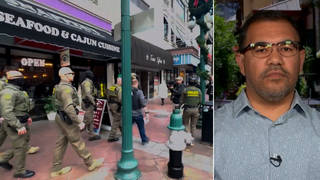
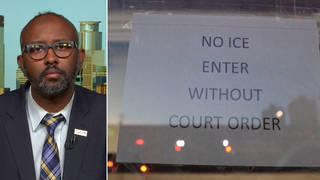
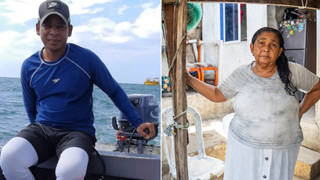
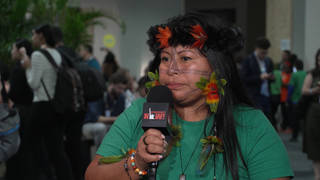

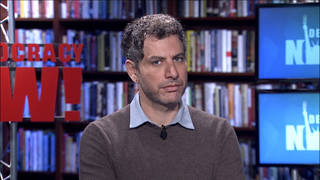
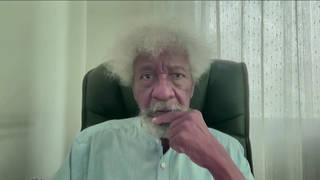

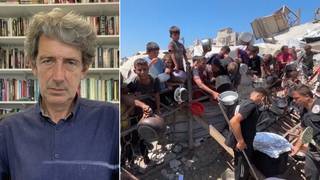

Media Options